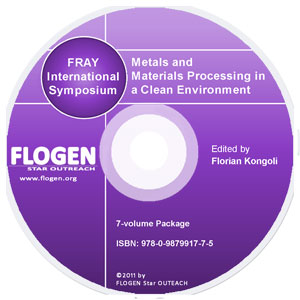
CD shopping page |
2011-Sustainable Industrial Processing Summit
|
| Editors: | Florian K |
| Publisher: | Flogen Star OUTREACH |
| Publication Year: | 2012 |
| Pages: | 764 pages |
| ISBN: | 978-0-9879917-5-1 |
| ISSN: | 2291-1227 (Metals and Materials Processing in a Clean Environment Series) |
Analysis Of Alternatives For The Degradation Of The Cyanide In Liquids And Solids Effluents In Colombia
Oscar Restrepo1; Ana Gaviria1;1NATIONAL UNIVERSITY OF COLOMBIA, Medellin, Colombia;
Type of Paper: Regular
Id Paper: 57
Topic: 14
Abstract:
Different cyanide forms exist according to their composition and stability, each one with different toxicity grade. the most toxicity is the free cyanide. The mensuration of concentration of the cyanide can be carried out by diferents methods.The free cyanide in solution can transform to less toxic forms by means of the natural degradation, precipitation, cyanide recovery, adsorption has more than enough activated carbon and oxidation being this last one the most applied. This paper presents the evaluation of degradation tests for oxidation of cyanide applied to solids and liquids effluents, and pulps of different treatments in the mill, located in the county of Segovia at Antioquia and Marmato, at Caldas - Colombia.The technological alternatives researched for at the oxidation of cyanide in effluents of solids and liquids taken in Segovia, were: sodium hypochlorite, hydrogen peroxide and the combination of the reagents before mentioned.For the treatment with sodium hypochlorite it is required 12.5 kg NaOCl/kg CN- - for a time of 40 minutes; while for the process with hydrogen peroxide it is needed 3.5 kg H2O2/kg CN- - for a time of 2.5 h. For the combination of the methods of the sodium hypochlorite with hydrogen peroxide is required 2.5 kg H2O2/kg CN, with 5 kg NaOCl/kg CN- for a time of 20 minutes. The samples taken in Marmato, correspond to pulp mineral that leave the extractive process and that it contains high cyanide concentrations. In these samples the degradation was applied by oxidation using hydrogen peroxide and the Caro´s acid (AC).The speeds in the degradation indicated a reduction of the cyanide content in more than 93% in a time of 4 h for the use of the hydrogen peroxide and, 5 minutes for the use of the Caro´s acid, with relationships among the H2O2/CN- of 2,5 and AC/CN- of 2 and H2SO4/H2O2 of 2.